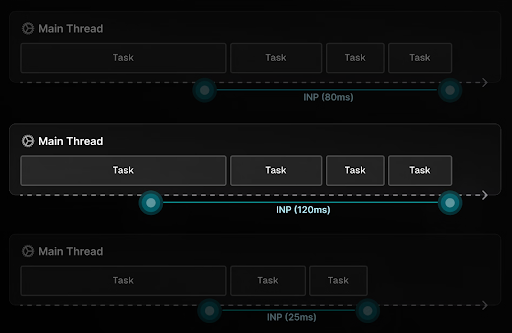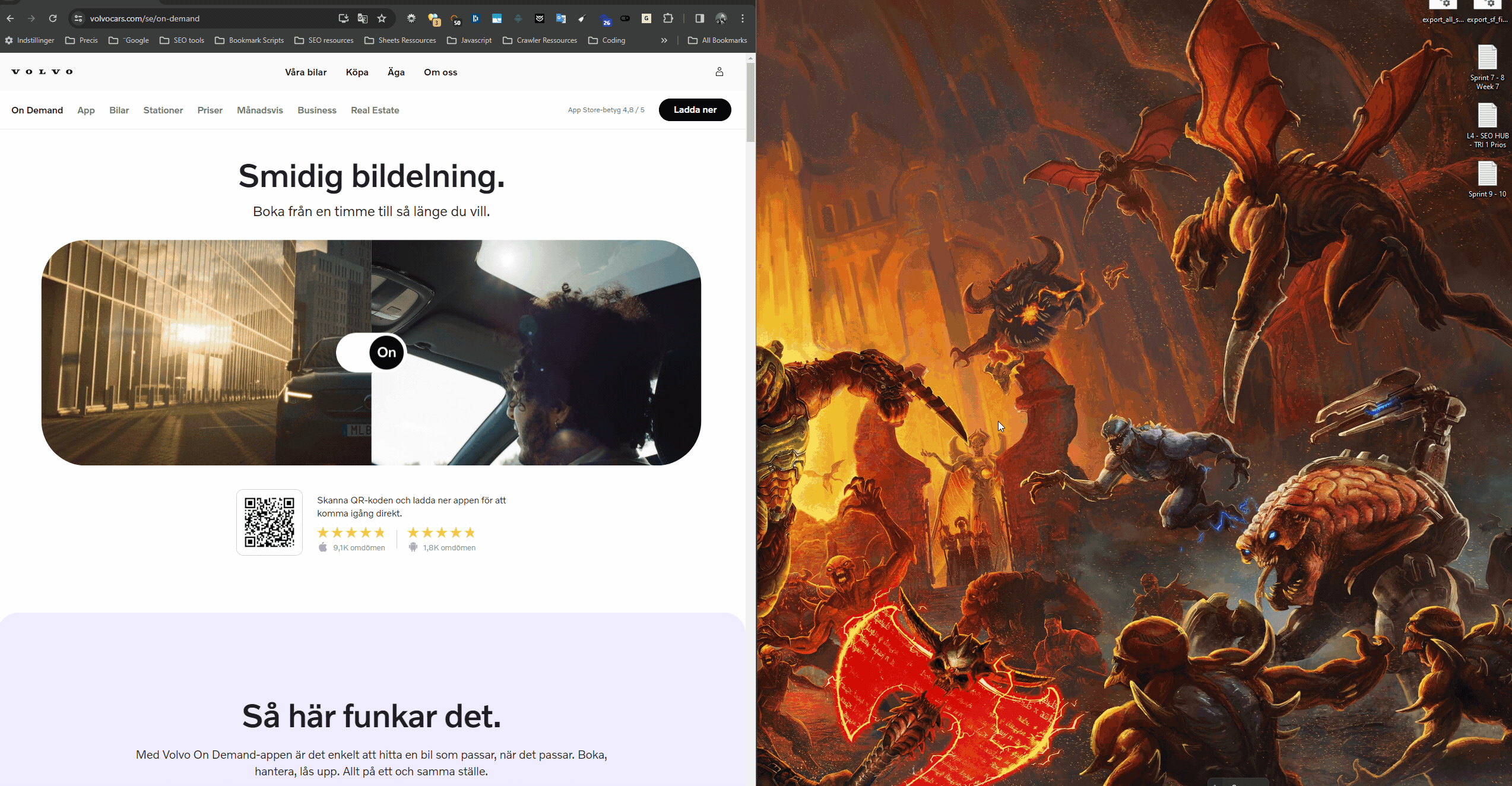Exploring INP: The future of web performance metrics

Frederik Stilund Drost
Senior SEO Solutions Engineer
In web development, Google’s new metric, Interaction to Next Paint (INP), is reshaping how we evaluate and enhance user experiences online.
Here’s a deep dive into what INP is, its significance, and how to optimise it.
1. What is INP?
Interaction to Next Paint (INP) is a cutting-edge metric designed to measure a webpage’s responsiveness and interactivity more comprehensively than First Input Delay (FID). While FID focuses solely on the delay before the browser begins processing the first user interaction, INP extends this by evaluating all interactive responses, capturing the full spectrum of user experiences on a page.
This holistic approach ensures a more accurate reflection of real-world user satisfaction, as it accounts for the worst-case scenarios in interactivity.

For your website, this means you will have to look deeper at all your user interactions to satisfy Google’s new metrics, which is a ranking factor and helps improve overall user experience, which can lead to better conversion rates and higher retention.
2. When will INP replace FID?
When this was written, Google announced that FID would be replaced with INP on the 12th of March, 2024.
2.1. INP vs. FID: understanding the difference
While FID has served as a standard for evaluating the initial responsiveness of a web page, it only scratches the surface of user experience. FID measures the time from a user’s first interaction to the browser’s response, but it neglects subsequent interactions that are equally critical to user satisfaction.
2.2. The limitations of FID

In practice, FID’s narrow focus can obscure the broader picture of site performance. It doesn’t account for the myriad interactions a user might engage in after the page has loaded. This oversight can lead to a skewed perception of a site’s responsiveness and, by extension, its overall user experience.
2.3. Advantages of INP

INP addresses these shortcomings by considering the entire range of user interactions within a session. This metric not only includes the initial input delay but also encompasses the processing and presentational delays that follow.

By measuring the longest interaction delay experienced by the user, INP offers a more rounded view of a site’s interactive performance.
3. How do you measure INP?
INP can be measured using tools like Google’s CrUX report or PageSpeed Insights, which now incorporate INP metrics alongside other Core Web Vitals.
3.1. Tools for measuring INP
Chrome User Experience Report (CrUX)
Advantages:
- Provides real-world user experience data from millions of websites.
- Offers insights into historical trends and comparisons across different demographics.
- Accessible through BigQuery for advanced analysis.
Disadvantages:
- Data is aggregated, which might not reflect the specific issues of individual pages.
- Updates are bi-weekly, not real-time, which can delay action on recent changes.
PageSpeed insights
Advantages:
- Combines lab data with real-world CrUX data for a comprehensive view.
- Offers specific recommendations for improving page performance.
- Easy to use, providing a straightforward score and detailed issue breakdown.
Disadvantages:
- CrUX data is not available for all URLs, so you might just see your site’s aggregated data on a given URL.
- Performance Score does not use interaction metrics in its calculations (yet)
Chrome DevTools
Advantages:
- Enables detailed, real-time analysis of user interactions and painting times.
- Provides granular data on scripting, rendering, and other processes affecting INP.
- Free and integrated into the Chrome browser.
Disadvantages:
- Requires a higher level of technical expertise to interpret and act on the data.
- The analysis is limited to the conditions under which the test is conducted, which may not cover all user scenarios.
3.2. Strategies for measuring INP
When measuring INP, it’s crucial to adopt a strategy that aligns with your website’s specific needs and user base. Here are some approaches:
- Real-World Monitoring: Leverage tools like CrUX to monitor INP across real user interactions. This approach helps understand how actual users experience your site across different devices and network conditions. However, be mindful that real-world data can be noisy and may require segmentation to identify meaningful trends.
- Custom Analysis: For in-depth investigation, use Chrome DevTools to analyze specific interactions and identify bottlenecks. This method is particularly effective for debugging complex issues but requires a solid understanding of web technologies and performance metrics.
3.3. Balancing act: choosing the right approach
In practice, a balanced approach combining real-world monitoring, lab testing, and custom analysis often yields the best results. Real-world data provides the context and scope, lab testing offers controlled analysis and debugging, and custom analysis allows for deep dives into specific issues.
By understanding the strengths and limitations of each tool and approach, you can develop a comprehensive strategy for measuring and improving INP, leading to a faster, more responsive website that better meets your users’ needs.
4. Identifying and fixing INP issues
To pinpoint and resolve INP-related problems, web developers can employ Chrome DevTools, specifically the Performance tab, to record and analyse user interactions.

This method involves inspecting tasks that take too long to complete and investigating the causes behind these delays. Solutions may range from optimising JavaScript execution to implementing visual cues like loading indicators, which inform users that a process is underway, mitigating premature re-interactions.
Moreover, developers should prioritise optimising tasks that directly affect user interactions. This might include deferring non-critical JavaScript, streamlining event handlers, or preloading essential resources. By addressing these areas, websites can significantly enhance their responsiveness, leading to better INP scores and, ultimately, improved user satisfaction.
5. Case study: an anonymous user interaction scenario
In our practical analysis, we applied our learnings to an unnamed web application, examining a specific user interaction scenario. By employing Chrome’s DevTools, we recorded and dissected user actions, identifying performance bottlenecks related to interaction delays.
5.1. Detailed analysis approach
Our methodology involved initiating the recording prior to user interactions, enabling us to capture a comprehensive range of user behaviours.

We could identify areas of excessive scripting and processing delays by examining the detailed frames and tasks associated with each interaction. This granular approach facilitated targeted discussions on optimisation strategies.
In our case study, the primary challenge was to streamline a feature that required extensive scripting to deliver dynamic content based on user interactions.
We explored strategies such as preloading scripts and content, thereby ensuring immediate responsiveness upon user interaction. This approach significantly improved the INP score, enhancing the user experience by minimising delays.
6. Collaborating with developers for Enhanced INP
Improving INP is not a one-man show; it requires close collaboration between SEO specialists and developers.
By sharing insights from INP measurements and identifying specific areas of concern, teams can work together to devise and implement effective solutions. Whether it’s simplifying complex scripts, preloading content, or refining interaction handlers, a joint effort is crucial in navigating the technical challenges posed by INP optimisation.
Conclusion
In conclusion, INP represents a significant leap forward in our understanding and evaluation of web performance. By focusing on the broader spectrum of user interactions, INP provides a more nuanced and accurate picture of a site’s responsiveness. As web standards continue to evolve, staying ahead in the INP game will be essential for providing superior user experiences and maintaining a competitive edge online.
Want to know more? We’ve got you covered:


